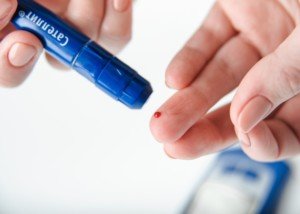
Is there a difference between how a diabetic should train for building muscle and someone without diabetes?
Do the exercises differ? What about the bench press?
Let’s put it this way: A muscle cell, when responding to the stimulus of lifting weights, does not “know” whether or not the body that it’s in is diabetic.
Muscle cells have a predictable way of responding to the stimulus of an imposed demand. They’re going to respond the same way every single time: It’s called adaptation.
“Strategies for increasing muscle mass for individuals with and without diabetes are the same,” says Alison Massey, MS, RD, LDN, registered dietitian and certified diabetes educator with over 10 years of experience in various community and clinical settings.
“Individuals need to focus on a proper strength training regimen and eat a healthy diet with enough calories,” adds Massey.
That’s the same recommendation for non-diabetic people who want to build big muscles.
But doesn’t diabetes make SOME difference in building muscle?

Shutterstock/miami beach forever
Massey explains, “Individuals with diabetes might have to take extra precautions if they are modifying or changing their workout routine, and should monitor blood glucose before working out and during (if needed).
“Hydration is key; dehydration can contribute to elevated blood glucose levels.”
Diabetic muscle-building enthusiasts should have a quick-acting carbohydrate source on hand (juice is a favorite) as well as make generous trips to the drinking fountain if they’re not carrying a water bottle.
Having diabetes does not create a physiological or biochemical barrier to building big muscles.
The barrier in ANYONE who is struggling to build muscle is almost always incorrect training and inadequate nutrition.
Examples of Incorrect Training and Improper Nutrition
• Doing the wrong exercises
• Inadequate rest between training days
• Insufficient calories and/or improper nutrition
• Not lifting heavy enough or intensely enough
If you’re diabetic and want to build big muscles, you must focus on compound exercises. Classic compound moves that build mass include:
• Flat and angled bench press – diabetes does not contraindicate this movement, nor any of the following movements.

Freepik.com
• Dumbbell shoulder press
• Any kind of row (e.g., bent-over barbell, T-bar, corner bar)
• Lat pull-down
• Dip
• Squat (back, front, hack)
• Leg press
• Leg extension and leg curl
• Deadlift, rack pull

Freepik.com
I can go on and on about number of sets, reps, how long to rest in between, sequence of exercises, intensity techniques, etc., but the focus of this article is how a diabetic can put on a lot of muscle.
A key factor for diabetics is the post-workout meal. It should be within 30-60 minutes of the end of the workout (if blood sugar is in the normal range at that point; it should be checked at the end of the workout and dealt with accordingly).
The post-workout meal should consist of 25-30 grams of high quality protein (fish, poultry, grass-fed beef, lamb, eggs – not fast-food or processed protein sources like microwavable salisbury steak) and a good portion of a healthy carb source like wild rice, boiled potato, barley, quinoa, yams.
You need not give up bread, but whole-grain is best.
Another key point is to remember that the training protocol — as far as the actual workouts — for diabetics is the same as it is for the typical individual who wants to build a lot of muscle mass.
Alison Massey has been working in the field of nutrition since 2010 helping individuals make sustainable changes to improve their health.
 Lorra Garrick has been covering medical, fitness and cybersecurity topics for many years, having written thousands of articles for print magazines and websites, including as a ghostwriter. She’s also a former ACE-certified personal trainer.
Lorra Garrick has been covering medical, fitness and cybersecurity topics for many years, having written thousands of articles for print magazines and websites, including as a ghostwriter. She’s also a former ACE-certified personal trainer.
.










































